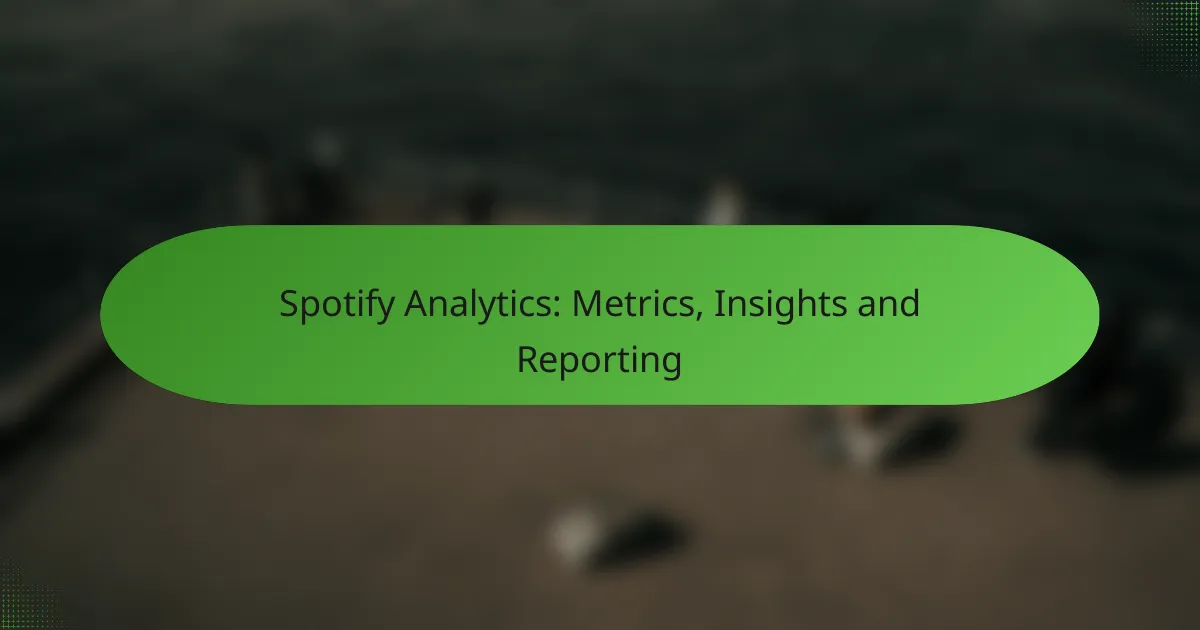Spotify Analytics offers essential metrics that reveal how music is performing on the platform, enabling artists and marketers to make data-driven decisions. By utilizing the Spotify for Artists platform, users can access detailed insights on streams, listeners, and audience demographics, which are crucial for enhancing engagement. Understanding and interpreting these metrics allows for a more effective content strategy and improved audience reach.
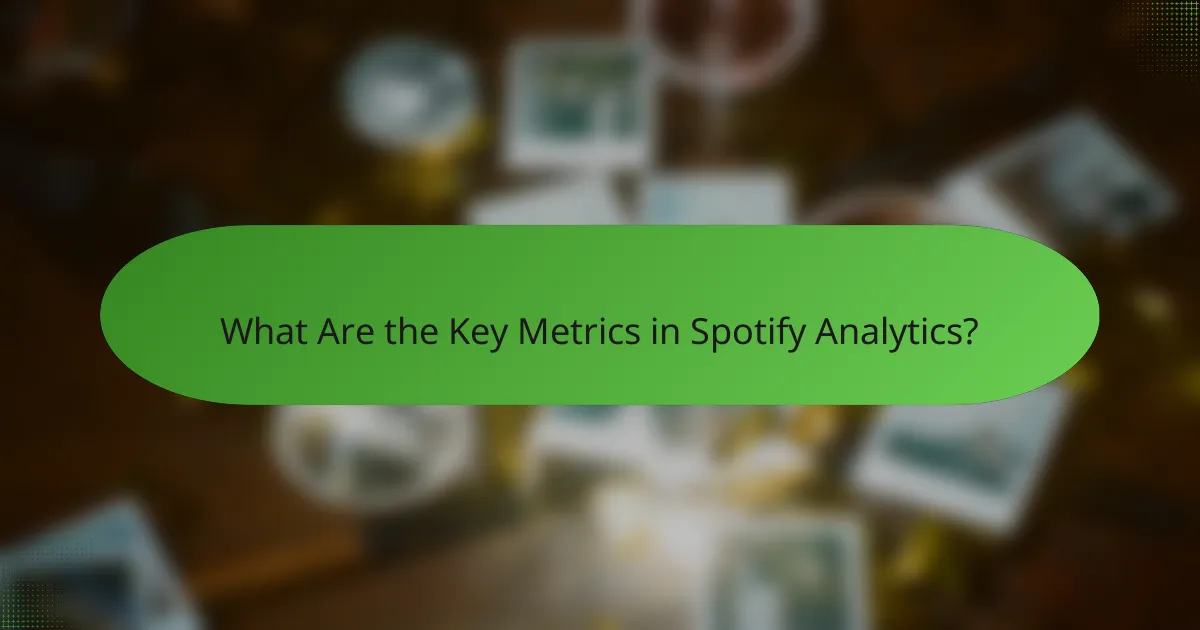
What Are the Key Metrics in Spotify Analytics?
The key metrics in Spotify Analytics provide insights into how music is performing on the platform. Understanding these metrics helps artists and marketers make informed decisions to enhance engagement and reach their audience effectively.
Stream Count
Stream count refers to the total number of times a track has been played on Spotify. This metric is crucial for gauging a song’s popularity and can influence its placement on playlists and charts.
To maximize stream count, focus on promoting your music through social media and collaborations. Regularly releasing new content can also keep listeners engaged and increase overall plays.
Listener Demographics
Listener demographics provide insights into the age, gender, location, and listening habits of your audience. This information is vital for tailoring marketing strategies and understanding who your fans are.
Utilize demographic data to create targeted campaigns. For instance, if a significant portion of your listeners are in a specific age group, consider crafting content that resonates with their interests and preferences.
Engagement Rate
Engagement rate measures how actively listeners interact with your music, including actions like saving songs, sharing, or adding them to playlists. A high engagement rate indicates a strong connection with your audience.
To boost engagement, encourage fans to share your music and create interactive content, such as polls or Q&A sessions. Engaging with your audience through live performances or social media can also enhance this metric.
Playlist Adds
Playlist adds track how many times your songs are included in user-generated or curated playlists. Being added to popular playlists can significantly increase exposure and streams.
To increase playlist adds, submit your music to playlist curators and engage with fans who create playlists. Building relationships with influencers in your genre can also help get your tracks featured.
Conversion Rate
Conversion rate indicates the percentage of listeners who take a desired action, such as following your artist profile or purchasing merchandise. This metric is essential for measuring the effectiveness of your promotional efforts.
To improve conversion rates, ensure clear calls to action in your marketing materials. Offering exclusive content or limited-time promotions can also incentivize listeners to convert into loyal fans.
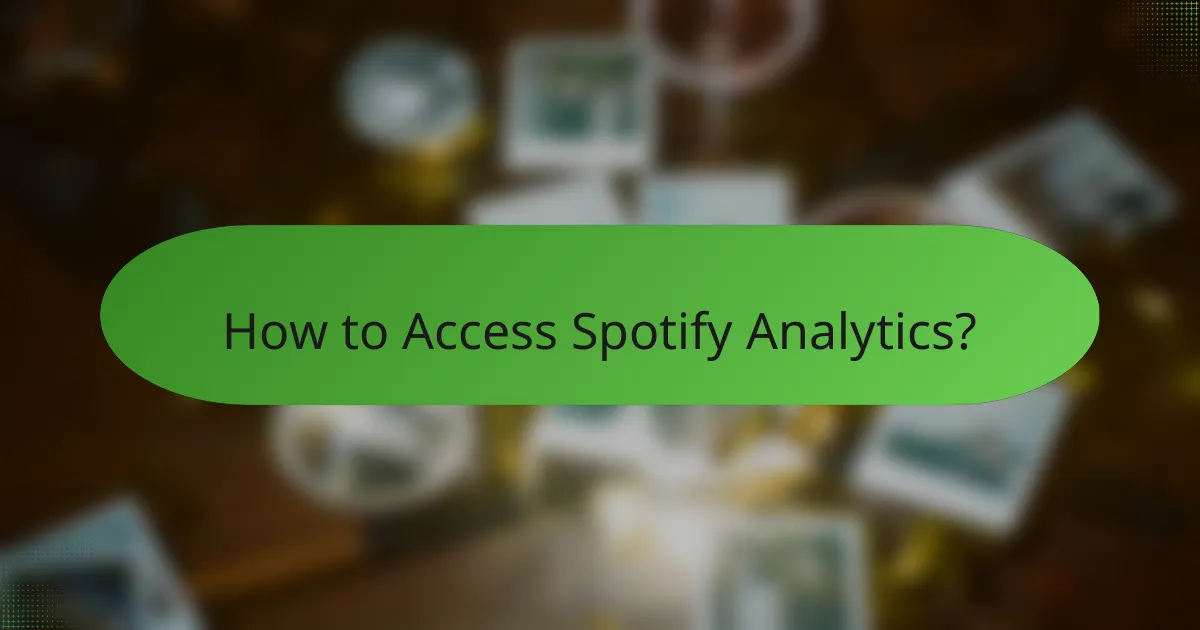
How to Access Spotify Analytics?
To access Spotify Analytics, you need to use the Spotify for Artists platform, which provides detailed insights into your music’s performance. This tool allows artists to track metrics such as streams, listeners, and demographic information about their audience.
Using Spotify for Artists
Spotify for Artists is the primary tool for accessing analytics related to your music. After signing up and claiming your profile, you can view various metrics that help you understand your audience and track your growth. Key features include real-time data on streams, listener demographics, and playlist placements.
Make sure to regularly check your analytics to identify trends and adjust your marketing strategies accordingly. Understanding which songs perform best can guide your future releases and promotional efforts.
Accessing the Dashboard
The dashboard in Spotify for Artists is user-friendly and provides a comprehensive overview of your music’s performance. You can navigate through different sections to view metrics such as total streams, monthly listeners, and geographic distribution of your audience. Each metric is updated frequently, allowing you to stay informed about your progress.
Utilize the filter options to analyze specific time periods or compare different tracks. This can help you pinpoint successful marketing campaigns or identify songs that may need more promotion.
Mobile App Features
The Spotify for Artists mobile app offers convenient access to your analytics on the go. You can view key metrics, receive notifications about significant changes, and even manage your profile directly from your smartphone. This flexibility allows you to stay connected with your audience and track your performance anytime, anywhere.
Take advantage of the app’s features, such as sharing insights with your team or planning social media posts based on your latest data. Regularly engaging with your analytics through the app can enhance your overall strategy and connection with fans.
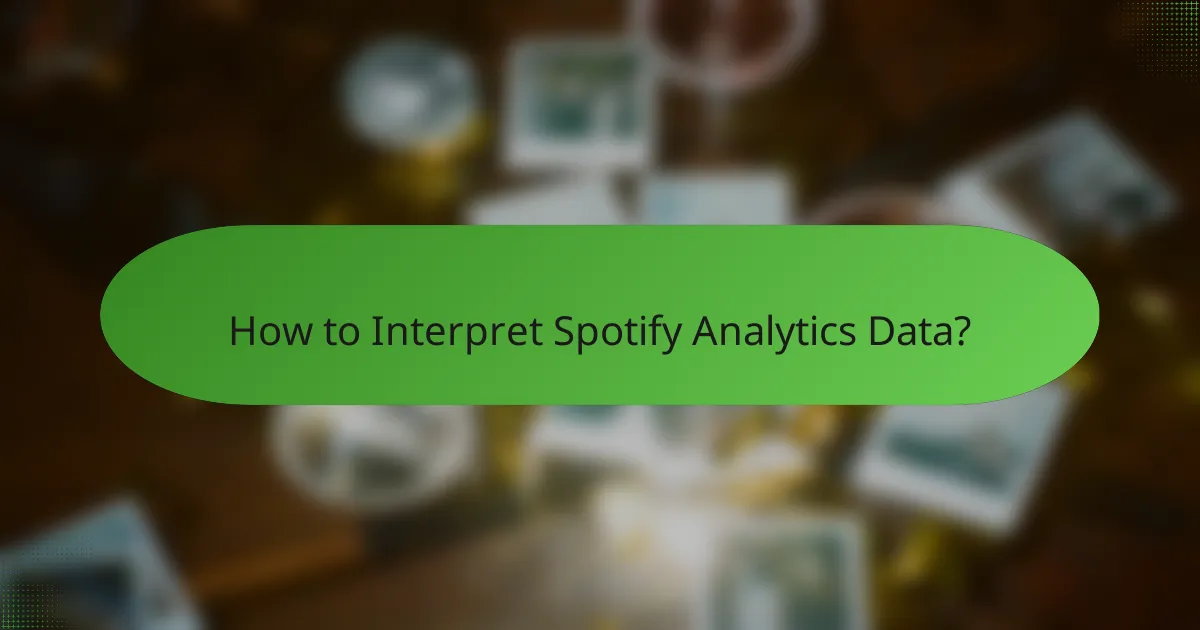
How to Interpret Spotify Analytics Data?
Interpreting Spotify Analytics data involves understanding key metrics that reflect your music’s performance and audience engagement. By analyzing these insights, you can make informed decisions to enhance your content strategy and reach your target listeners more effectively.
Understanding Trends
Identifying trends in your Spotify Analytics can reveal how your music is performing over time. Look for patterns in streams, saves, and playlist additions to gauge the popularity of specific tracks or albums. For instance, a steady increase in streams over several weeks may indicate growing listener interest.
Consider comparing different time frames, such as weekly or monthly data, to spot seasonal trends or the impact of promotional efforts. Regularly monitoring these trends can help you adjust your marketing strategies and release schedules accordingly.
Identifying Audience Preferences
Spotify Analytics provides demographic insights that help you understand your audience’s preferences. Metrics such as age, gender, and location can inform you about who is listening to your music and what genres resonate with them. For example, if a significant portion of your audience is from a specific country, you might consider tailoring your content or marketing efforts to that region.
Utilizing the data on listener behavior, such as the most popular tracks or playlists, can guide your future music production. Focus on creating content that aligns with the tastes of your core audience to foster deeper connections and encourage loyalty.
Evaluating Campaign Performance
To evaluate the effectiveness of your marketing campaigns, track the changes in your Spotify Analytics metrics before and after your promotional efforts. Look for increases in streams, followers, and engagement rates to assess whether your campaigns are driving results. For instance, a spike in followers after a social media campaign may indicate successful outreach.
Additionally, consider setting specific goals for each campaign, such as increasing streams by a certain percentage or gaining a specific number of followers. This will help you measure success more accurately and refine your strategies for future campaigns based on what works best.
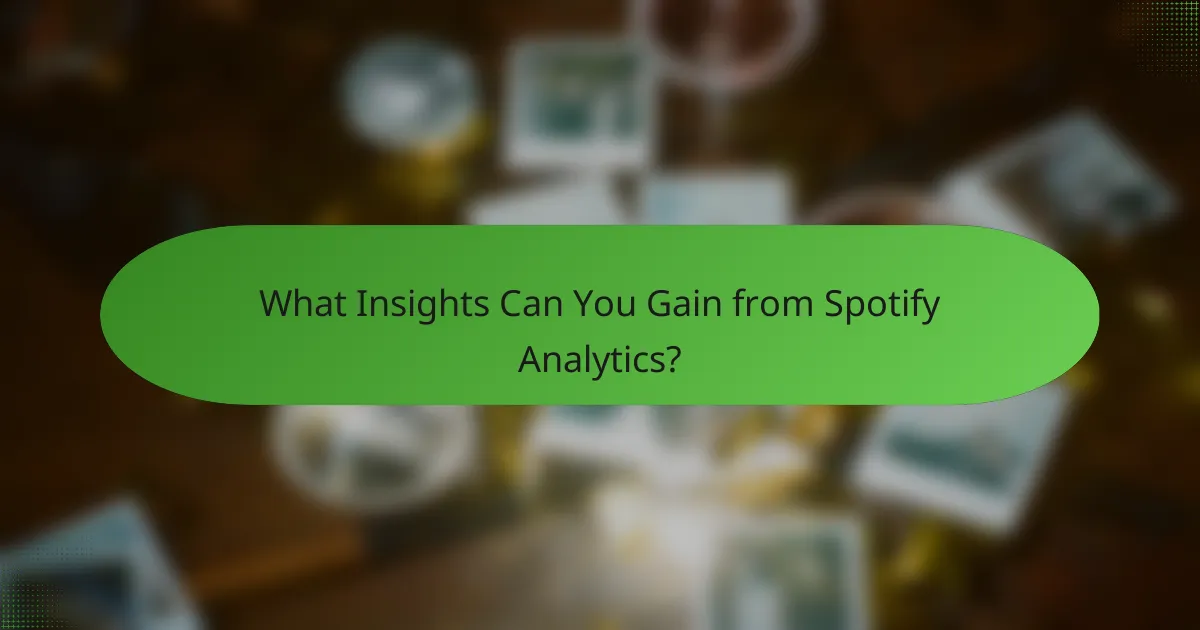
What Insights Can You Gain from Spotify Analytics?
Spotify Analytics provides valuable insights into how your music is performing, who your listeners are, and how they engage with your content. By analyzing these metrics, you can make informed decisions to enhance your music strategy and grow your audience.
Content Performance Insights
Content performance insights focus on how individual tracks, albums, or playlists are performing on Spotify. Key metrics include stream counts, listener demographics, and playlist placements. Understanding which songs resonate most with your audience can guide your future music production and marketing efforts.
For example, if a particular track garners significantly more streams than others, consider creating similar content or promoting it more aggressively. Regularly reviewing these metrics can help identify trends and shifts in listener preferences.
Marketing Strategy Adjustments
Marketing strategy adjustments can be informed by the insights gained from Spotify Analytics. By analyzing listener demographics and engagement patterns, you can tailor your promotional efforts to reach the right audience effectively. This may involve adjusting your social media campaigns or targeting specific playlists that align with your music style.
For instance, if analytics show a high concentration of listeners in a particular region, consider organizing local events or targeted ads in that area. This localized approach can enhance your visibility and foster a stronger connection with your fan base.
Fan Engagement Strategies
Fan engagement strategies are crucial for building a loyal listener base. Insights from Spotify Analytics can help you understand how fans interact with your music, including their listening habits and preferences. Engaging with fans through personalized content or exclusive releases can strengthen their connection to your brand.
Consider using features like Spotify Canvas or Stories to create visual content that complements your music. Additionally, responding to fan feedback and incorporating their suggestions can enhance their experience and encourage ongoing support.
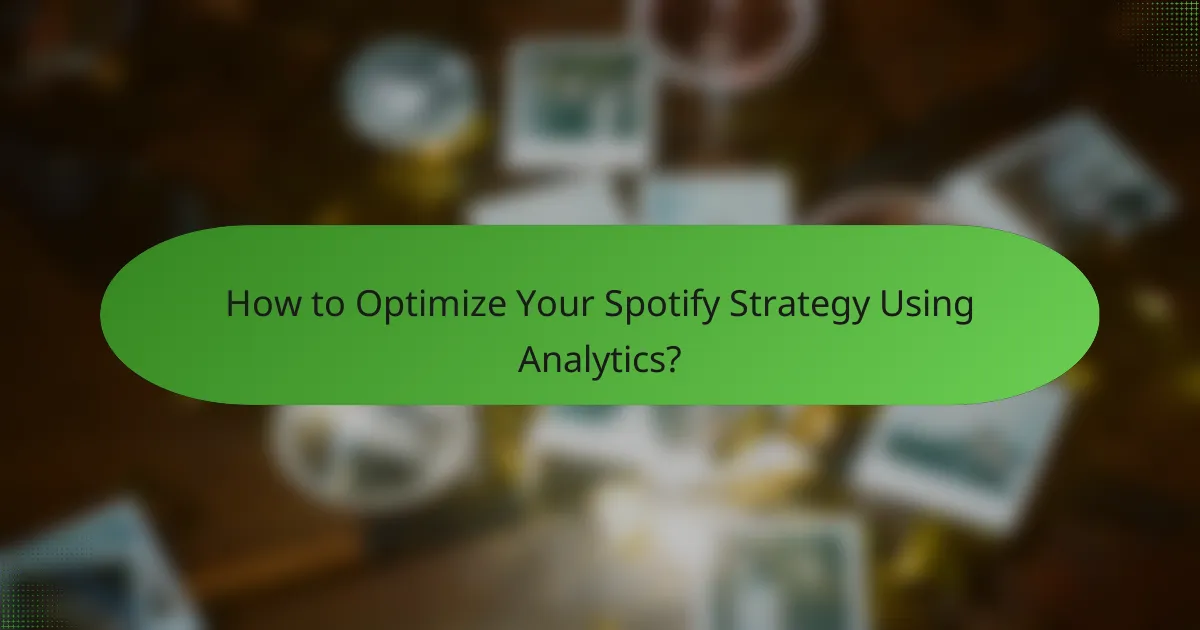
How to Optimize Your Spotify Strategy Using Analytics?
To optimize your Spotify strategy using analytics, focus on understanding key metrics that reflect listener engagement and track performance trends. By leveraging these insights, you can make informed decisions to enhance your content and marketing efforts.
Key Metrics to Monitor
When optimizing your Spotify strategy, prioritize metrics such as streams, listener demographics, and playlist placements. Streams indicate how often your tracks are played, while listener demographics provide insights into who is engaging with your music, including age, gender, and location.
Additionally, keep an eye on playlist placements, as being featured on popular playlists can significantly boost your visibility and streams. Regularly reviewing these metrics helps you identify which songs resonate with your audience and where to focus your promotional efforts.
Understanding Listener Engagement
Listener engagement metrics, such as saves, shares, and follows, are crucial for assessing how well your music connects with your audience. A high number of saves indicates that listeners appreciate your tracks enough to keep them in their libraries, while shares can expand your reach to new potential fans.
Engagement can also be measured through the average listen duration. If listeners are dropping off before the end of your songs, consider adjusting your songwriting or production to maintain interest throughout the track.
Utilizing Spotify for Artists
Spotify for Artists is an essential tool for accessing detailed analytics about your music’s performance. It provides real-time data on streams, audience demographics, and engagement metrics, allowing you to make timely adjustments to your strategy.
To get the most out of Spotify for Artists, regularly check your dashboard and set specific goals based on the insights you gather. For example, if you notice a spike in streams from a particular region, consider targeting that area with localized marketing efforts or virtual performances.
Creating Actionable Reports
Creating actionable reports from your Spotify analytics can help streamline your decision-making process. Focus on summarizing key metrics and trends over specific periods, such as weekly or monthly, to identify patterns in listener behavior.
When compiling reports, include visual elements like charts or graphs to illustrate trends clearly. This can make it easier to share insights with your team or collaborators, ensuring everyone is aligned on your strategy moving forward.
